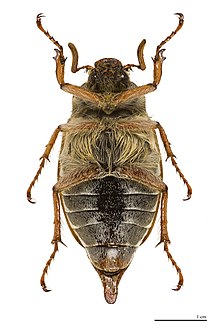Melolonthini

Taxonavigation
[edit]| Taxonavigation: Scarabaeoidea |
|---|
|
Superregnum: Eukaryota |
Familia: Scarabaeidae
Subfamilia: Melolonthinae
Tribus: Melolonthini
Subtribus (7): Enariina - Heptophyllina - Leucopholina - Melolonthina - Pegylina - Rhizotrogina - Schizonychina
[subtribus after Smith (2006)]
Overview of genera (201)
[edit]Achranoxia – Adoretops – Aethiartrogus – Afrolepis – Alepida – Allothnonius – Amblonoxia – Amphimallina – Anartioschiza – Anisopholis – Anomalochela – Anoxia – Anoxoides – Antitrogus – Apogonia – Aposchiza – Articephala – Asactopholis – Asaphomorpha – Asophrops – Asthenopholis – Aulacoschiza – Barryfilius – Beriqua – Brachylepis – Brachyllus – Brachypholis – Brahmina – Butozania – Byrsalepis – Carlschoenherria – Cephaloschiza – Chaetocosmetes – Cheronia – Chiloschiza – Chilotrogus – Clypeasta – Cnemoschiza – Cochliotis – Cochliotodes – Coelogenia – Coniopholis – Coniotrogus – Crepischiza – Cryphaeobius – Cryptotrogus – Cyphochilus – Cyphonotus – Cyphonoxia – Dasylepida – Dermolepida – Diacucephalus – Dicheloscema – Dinacoma – Diplotaxys – Empecta – Empectida – Empectoides – Empycastes – Enaria – Encya – Energetia – Enthora – Entyopsis – Entypophana – Eremotrogus – Eulepidopsis – Eupegylis – Euranoxia – Eutrichesis – Exolontha – Exopholis – Genyoschiza – Globulischiza – Glyptoglossa – Grananoxia – Gymnogaster – Gymnoschiza – Hecistopsilus – Heptelia – Heptophylla – Heteroschiza – Hexataenius – Hilyotrogus – Holisonycha – Holomelia – Holopycnia – Holorhopaea – Holotrichia – Homoeoschiza – Hoplochelus – Hoplocnemus – Hoplolontha – Hoplosternodes – Hoplosternus – Hypochrus – Hypolepida – Hypopholis – Hypothyce – Hypotrichia – Idiapogonia – Idionycha – Jalalabadia – Lachnodera – Lachnosterna – Lachnota – Lasiexis – Lasiotropus – Latipalpus – Lecantotrogus – Lepidiota – Lepidomela – Lepidotrogus – Lepischiza – Leucopholis – Leucophorus – Magniscarabaeus – Malaisius – Mascarena – Megacoryne – Meganoxia – Megarhopaea – Megistophylla – Melolontha – Melolonthoides – Metatrogus – Microlontha – Microphylla – Microrhopaea – Microtrichia – Miolachnosterna – Miridiba – Nanorhopaea – Nematophylla – Ochranoxia – Octoplasia – Oligophylla – Oreotrogus – Othnonius – Pachrodema – Pahangia – Panotrogus – Pararhopaea – Pectinichelus – Pegylis – Pentaphylla – Pentelia – Phiara – Philacelota – Pholidochris – Phyllophaga – Plectrodes – Pollaplonyx – Polyenaria – Polyphylla – Polyphyllum – Proagosternus – Proseconius – Proteroschiza – Pseudenaria – Pseudholophylla – Pseudoapterogyna – Pseudodiplotaxis – Pseudoholophylla – Pseudolontha – Pseudopantrogus – Pseudopholis – Pseudosymmachia – Psilonychus – Psilopholis – Ramilia – Redotus – Rhabdopholis – Rhadinolontha – Rhizoproctus – Rhopaea – Rhyxicephalus – Rhyxiderma – Rubilepis – Schismatocera – Schistocometa – Schizonycha – Sebakue – Semienaria – Shangaia – Sophrops – Spaniolepis – Spathoschiza – Stenopegylis – Stephanopholis – Suntemnonycha – Syngeneschiza – Terebrogaster – Thyce – Toxospathius – Trematodes – Tricholepis – Trichoschiza – Trigonocnemus – Trinoxia – Unguiculenaris – Vadonaria – Xenotrogus – Zietzia
Name
[edit]Melolonthini Leach, in Samouelle, 1819
Synonyms
[edit]- Rhizotrogini Burmeister, 1855 [subtribe]
References
[edit]- Leach, W.E. 1819. [new genera]. In: Samouelle G.: The entomologist’s useful compendium; or an introduction to the knowledge of British insects comprising the best means of obtaining and preserving them, and a description of the apparatus generally used; together with the genera of Linné, and the modern method of arranging the classes Crustacea, Myriapoda, spiders, mites and insects from their affinities and structure, according to the views of Dr. Leach. Also an explanation of the terms used in entomology: a calendar of the times of appearance, and usual situations of near 3000 species of British insects; with instructions for collecting and fitting up objects for the microscope. London: Thomas Boys, 496 pp. BHL Reference page.
cited sources
[edit]- Hardy, A.R. 1974: Revisions of Thyce LeConte and related genera (Coleoptera: Scarabaeidae). Occasional Papers (Entomology, State of California) 20: 1–47. Full article: [1].
- Sehnal, R. 2018. A new species of Brachylepis Kolbe, 1894 from Tanzania (Scarabaeidae: Melolonthinae: Leucopholini). Zootaxa 4377(2): 291–295. DOI: 10.11646/zootaxa.4377.2.9 Full article (PDF) Reference page.
- Smith, A.B.T. 2006: A review of the family-group names for the superfamily Scarabaeoidea (Coleoptera) with corrections to nomenclature and a current classification. Coleopterists Society monograph, 5: 144–204. DOI: 10.1649/0010-065X(2006)60[144:AROTFN]2.0.CO;2 PDF